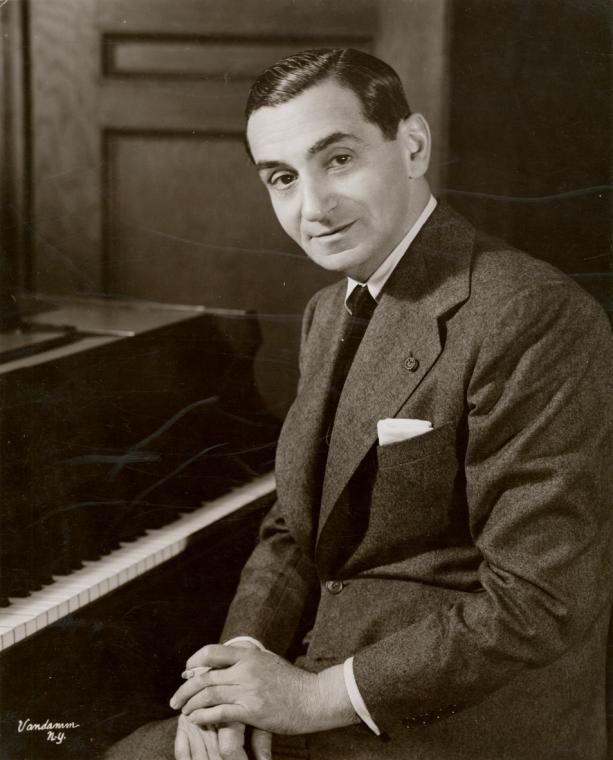Popular Music
"...a half-acre of strings..." Sinatra on the Radio
Frank Sinatra was, as the Library for the Performing Arts exhibition attests, an American icon. The project, a collaboration of LPA and the GRAMMY Museum with Frank Sinatra Enterprises, focuses on him as one of the great artists of recorded sound—in his work with Columbia, Capitol and Reprise Records. Not just as a singer but as an A&R man, connecting the artist with the best repertory for his voice as it changed and matured.
The project also allows us to reveal his work on radio, as preserved in our Rodgers & Hammerstein Archives of Recorded Sound. There are two public programs—the first this weekend—of listening to Sinatra on the radio, as thousands of Americans would do every week. The first session focuses on an episode of Songs by Sinatra, broadcast on April 24, 1947 over CBS. It pays tribute to Irving Berlin’s forty years of songwriting and came to us as part of the Irving Berlin Collection of Non-Commercial Recordings. During the repartee with Sinatra before singing his first published song “Marie from Sunny Italy,” Berlin complains that he has to accompany himself on an old piano, while there are “a half-acre of strings” for Sinatra and his other guests.
Radio shows don’t stop for footnoting—that’s what blog posts are for, so here goes. Berlin’s comment refers to his well-known inability to play instruments other than piano and that only in one key. But it also refers to the musical journey that Sinatra took with arranger Axel Stordahl in the 1940s. As is illustrated in the exhibition, Sinatra’s earliest successes were as a vocalist with the big bands—of Harry James, Benny Goodman and, most importantly to his career, Tommy Dorsey. The big band sound performed and recorded by these popular ensembles was created by reed, brass and percussion instruments. Depending on the leader’s specialty, they generally had banks of 4 saxophones, 4 trumpets, 4 trombones, piano, bass and drums, a small vocal ensemble, and a vocalist.
When Sinatra left the Tommy Dorsey Orchestra, he and Stordahl experimented with alternative instrumentations to support his voice and the repertory for Columbia Records. This voyage of discovery can be traced in three LPA collections. You can listen to the original 78s or LPs and hear for yourself the difference between the big bands and Stordahl’s symphonic instrument sound (Rodgers & Hammerstein Archives of Recorded Sound). You can look through the half-dozen photographs by Bill Gottlieb of a Sinatra/Stordahl recording session at the Liederkrantz Club studio in 1947 (Music Division Iconography).
Also here at LPA and on display in the exhibit is a very unusual sources of musical documentation. Among the Billy Rose Theatre Division collections about performance in NY’s great picture palaces, there are stage manager’s records for the Paramount (Paramount Theatre Stage Managers Records *T-MSS 1989-015). In them, Paul Bracco carefully documented the band stand layouts for every ensemble that played the Paramount in the 1940s on the floorplans. You can see the conventional big band layout in band stand footprints (rectangles) and instrument names for Dorsey’s ensemble. But walk around the case and look at the layouts for Sinatra’s headlining bookings backed by the Gracie Barrie Orchestra (May 26 – June 22, 1943) and the Jan Savitt Orchestra (November 1945). Bracco drew and noted the massed strings and, for Savitt, even a harp on stage.
Songs by Sinatra had a live orchestra, whose members probably chuckled at Berlin’s joke. The audience may have been mystified, but the musicians understood that it was a tribute to Stordahl’s orchestrations and service as Sinatra’s music director, and also at the experimentation that it represented.
Read E-Books with SimplyE
 With your library card, it's easier than ever to choose from more than 300,000 e-books on SimplyE, The New York Public Library's free e-reader app. Gain access to digital resources for all ages, including e-books, audiobooks, databases, and more.
With your library card, it's easier than ever to choose from more than 300,000 e-books on SimplyE, The New York Public Library's free e-reader app. Gain access to digital resources for all ages, including e-books, audiobooks, databases, and more.
If you don’t have an NYPL library card, New York State residents can apply for a digital card online or through SimplyE (available on the App Store or Google Play).
Need more help? Read our guide to using SimplyE.
